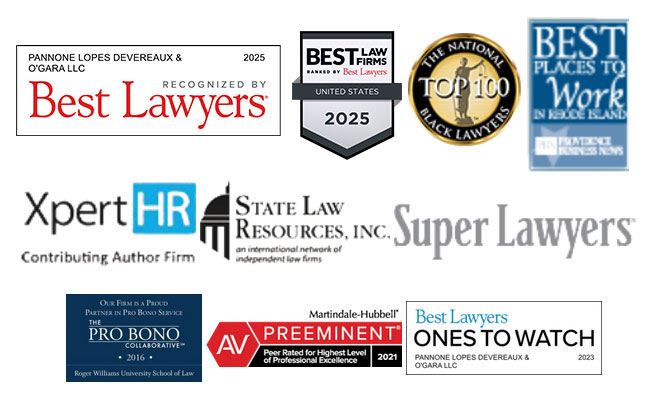Attention small and medium business owners! A recent federal court decision in the Eighth Circuit, Connelly v. United States (“Connelly”), which will soon be heard by the Supreme Court, should trigger reviews of your business succession plans, including your operating agreements, key man insurance policies, and buy-sell agreements, both in the corporate context, as well as within the estate plan of each key shareholder or member.
Starkweather & Shepley Insurance and Pannone Lopes Devereaux & O’Gara LLC have co-authored this Advisory to offer small and medium business owners key insights and recommendations from both a legal and insurance perspective.
Background
Two brothers, Michael and Thomas Connelly, owned a building materials company (the “Company”) together (Michael 77.18% and Thomas 22.82%). Years ago, the brothers wisely entered into a Stock Purchase Agreement (the “Agreement”) together. The Agreement provided that in the event of a brother’s death, the surviving brother had the right to purchase the deceased brother’s shares. If the surviving brother did not exercise that right, then the Company was required to purchase (redeem) the shares. To determine the price of the shares, the Agreement provided two mechanisms: the brothers could agree on the value each year in a signed certificate or, if they failed to do so, the brothers could obtain two or more appraisals of the fair market value of the Company’s shares. To fund the Company’s purchase of the shares, the Company purchased a life insurance policy on each brother in the amount of $3.5 million, better known in this context as “key man” or “key person” insurance.
After Michael died in 2013, the Company received a payout of $3.5 million from the Company’s insurance policy. No appraisals were obtained to determine the purchase price of Michael’s shares and the brothers had never agreed to the purchase price, as they were supposed to do annually. Rather, Michael’s son and Thomas agreed on $3 million as the purchase price for Michael’s shares; the remaining $500,000 went to the Company for operating costs. The $3 million figure thus valued the Company at $3.89 million based on Michael’s 77.18% ownership.
Michael’s estate (the “Estate”) tax returns reported that his shares were worth $3 million and the Estate paid the tax on the $300,000.
The IRS audited the Estate’s return and determined that the Estate had undervalued Michael’s shares because it did not factor in the insurance proceeds paid to the Company in determining the value of Michael’s shares. The true value of the Company was actually $6.86 million, not $3.89 million, because, according to the IRS, the $3.5 million in insurance proceeds the Company received was an asset that increased the Company’s value.
Business Succession 101
So, what is key person insurance and what was the goal of the Agreement? Understanding the answer to those questions will help demonstrate how important and far-reaching Michael’s and Thomas’s decisions are for other business owners.
The situations that may trigger a business succession include disability, retirement, death, termination of employment, and the divorce or bankruptcy of an owner. If you have the knowledge that it is likely for a business succession event to happen, it will give you the opportunity to provide for a smooth transition.
The most common types of business succession plans are referred to as “buy-sell agreements”, which are agreements among existing shareholders of a business and may take the form of entity/stock purchase, cross purchase, or a hybrid combination. There isn’t one type that is best suited for all businesses. Ultimately, the form should be made by the business owners, their accountants, attorneys, and others on their planning team. Once the type of agreement is confirmed, it is important to determine (1) who are the key people, and (2) the best way to fund the business succession plan.
Who is a Key Person?
A key person can be an owner of the business or an employee who makes a significant contribution to the success of the business and whose death or disability would almost certainly lead to the business suffering financial stress or even loss. Some characteristics that a key person may have include unique talents or skills, decision making power, a vision to plan for the future, and/or a unique ability to execute a plan or manage people.
How Do You Fund the Business Succession Plan?
There are five ways to fund a buy sell agreement, which are (1) company surplus, (2) company savings, (3) a third-party loan, (4) installment payments/seller loan and (5) life insurance. It’s not unusual to see more than one option being deployed. However, of these five, the installment and life insurance options are the most popular alternatives.
Enter Key Person Insurance
When using life insurance, there are many different ways to set the amount of insurance on a key employee. The multiple of salary method is most often used. It measures the value by multiplying the salary by a capitalization factor. This factor is usually set by the insurance carrier. For instance, a company determine the insurance to be 10x salary. The contributions of earning method include how much of a profit center is derived by the key person compared to other employees. Finally, the multiple of profits method considers whether or not there is an understudy, the time required to train a replacement and the availability of someone with the same skills and qualifications.
A business has an insurable interest in the life of any executive or employee actively associated with the business whose death would cause an actual financial loss for the business. As a result, the business can insure against that potential financial loss. They typically become the premium payor, owner, and beneficiary. However, insurable interest needs to be present at the time the policy is issued. If the employee leaves the business, the business may choose to continue to fund the policy, surrender the policy or sell the policy.
A business can use either term or permanent products as a key person policy. If permanent products are used, the cash value is an asset of the business, which they could access via loans or withdrawals for business purposes, including the loss of a key employee or other expenses.
How Much Tax Did Michael’s Estate Owe?
The key question in the Connelly case is whether the proceeds of the insurance policy should be added to the value of the Estate despite the supposed offsetting liability to purchase Michael’s shares under the Agreement. The Estate argued that the transaction, made in furtherance of the Agreement, itself determined the value of the Company, so that there was no need to conduct a fair market value analysis of the Company. Further, the insurance proceeds should not be counted in the fair market value of estate the Company because they were offset by the redemption obligation – in other words, the proceeds immediately passed from the Company to the Estate.
The Court quickly rejects the Estate’s argument that the Agreement determined the purchase price and fair market value of the Company. While the Internal Revenue Code does allow an agreement to fix valuation, the Agreement here contained no specific purchase price, nor did it contain a specific formula. The valuation process that it did call for, an averaging of independent fair market appraisals, would not be different than IRS’s own valuation approach. However, none of that truly matters, since the Estate and Thomas never actually engaged any appraisers.
More important is the second issue: Should the insurance proceeds be factored into the value of the Company for determining the size of deceased shareholder’s taxable estate?
Previously, the Eleventh Circuit in Estate of Blount v. Commissioner, 428 F.3d 1388 (11th Cir. 2005), ruled that a stock purchase agreement created a liability to redeem the deceased stockholder’s shares that offset the asset of the insurance proceeds. It held that “to suggest that a reasonably competent business person, interested in acquiring a company, would ignore a $3 Million liability strains credulity and defies any sensible construct of fair market value.”
The Connelly Court sides with the IRS and holds that Blount was decided incorrectly. Specifically, it rejects the notion that the Stock Purchase Agreement creates a liability that offsets the insurance proceeds. The court uses a hypothetical: If at the time of Michael’s death, there was a willing buyer for the Company, what would this hypothetical buyer pay for the Company? The Company was set to receive $3.5 million from the insurance policy on Michael’s life. A buyer would be getting both the Company and the proceeds of the insurance policy. Thus, any fair purchase price would take into account the value of that policy, namely the $3.5 million in proceeds. Likewise, a willing seller, knowing he would be getting the proceeds, would not sell the Company without factoring the value of that policy.
The entire premise of the IRS’s position, and the Connelly Court’s position, seemingly undercuts the purpose of key person insurance. As noted above, key person insurance is designed to prevent interruption to a company’s business when an obligation to purchase a shareholder’s shares is triggered by providing liquidity to the company at a critical time. Factoring the insurance proceeds into the value of the company creates additional concerns and liabilities.
What about the enforceable obligation to pay for Michael’s shares? The Connelly Court is unphased by it. The hypothetical buyer after purchasing the Company and getting the proceeds would either extinguish the stock purchase agreement or just redeem the shares from himself. According to the Court, “this is just like moving money from one pocket to another.”
Supreme Court Will Weigh In
Michael’s Estate did not give up after the Eighth Circuit’s ruling. It appealed the decision to the Supreme Court, which granted certiorari and will hear oral arguments in March 2024.
Key Takeaways
Clearly, Thomas and Michael, and later the Estate, should have actually observed the requirements of the Agreement. That the Estate is suffering the consequences of the failure to follow the Agreement is a clear undertone throughout the Court’s decision. Lawyers prepare agreements, including buy-sell, stock purchase agreements, and shareholder agreements to protect against certain unknowns that may happen in the future. Often, in order to take advantage of those protections, the agreement must actually be followed. For those shareholders who already have similar agreements in place, the critical takeaway is to follow the requirements of the agreement, including annual determinations of the Company’s value.
Given this dynamic legal and insurance landscape, Pannone Lopes Devereaux & O’Gara LLC and Starkweather & Shepley Insurance both recommend that small- to medium-sized business owners who have included a component of life insurance in their agreements schedule a conversation amongst their insurance professionals, estate lawyers, and corporate counsel. Furthermore, they should revisit their business succession plans and agreements upon changes in ownership or significant revaluations of the underlying business interest.


